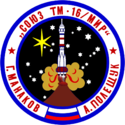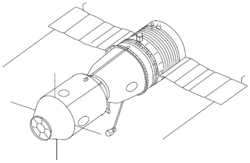Sojuz TM-17
| Sojuz TM-17 (Союз ТM-17) | |||
 | |||
| Modell | Sojuz-TM | ||
|---|---|---|---|
| Anrop | Си́риус (Sirius) | ||
| Färdens tid | 196 dag, 17 tim, 45 min, 22 sek | ||
| Massa | 7 150 kg | ||
| NSSDC-ID | 1993-043A[1] | ||
| Uppskjutning | |||
| Startplats | Bajkonur LC1 | ||
| Start | 1 juli 1993, 14:32:58 UTC | ||
| Raket | Sojuz-U2 | ||
| Landning | |||
| Landningsplats | 130 km V om Karaganda | ||
| Landning | 14 januari 1994, 08:18:20 UTC | ||
| Omloppsbana | |||
| Varv | 3 070 st[2] | ||
| Apogeum | 397 km | ||
| Perigeum | 388 km | ||
| Banlutning | 51,6° | ||
| Besättning | |||
| Start | Vasili Tsiblijev Aleksandr Serebrov Jean-Pierre Haigneré | ||
| Landning | Vasili Tsiblijev Aleksandr Serebrov | ||
| Dockning | |||
| Rymdstation | Mir | ||
| Dockning | 3 juli 1993, 16:24:03 UTC | ||
| Port | fram | ||
| Ur dockning | 14 januari 1994, 04:37:11 UTC | ||
| Kronologi | |||
| |||
Sojuz TM-17 (ryska: Союз ТM-17) var en flygning i det ryska rymdprogrammet. Flygningen gick till rymdstationen Mir. Farkosten sköts upp med en Sojuz-U2-raket från Kosmodromen i Bajkonur den 1 juli 1993. Den dockade med rymdstationen den 3 juli 1993. Farkosten lämnade rymdstationen den 14 januari 1994. Några timmar senare återinträdde den i jordens atmosfär och landade i Kazakstan.
Kollision
Innan Sojuz TM-17 återvände till jorden skulle man fotografera dockningssystemet APAS-89 på Kristall-modulen. Tsiblijev klagade över att farkosten var trög i styrningen. Serebrov som skötte fotograferingen tyckte att man började komma alldeles för nära en av Mir:s solpaneler. Ombord på Mir fanns en besättning på tre personer, dessa evakuerades till Sojuz TM-18. Dryga minuten senare stötte Sojuz TM-17 mot Kristall-modulen. Ombord på Mir märkte man inte ens kollisionen.
Källor och referenser
- ^ ”NASA Space Science Data Coordinated Archive” (på engelska). NASA. https://nssdc.gsfc.nasa.gov/nmc/spacecraft/display.action?id=1993-043A. Läst 29 februari 2020.
- ^ Manned Astronautics - Figures & Facts Arkiverad 26 september 2015 hämtat från the Wayback Machine., läst 9 oktober 2016.
| |||||||||||||||||||||||||||||||||||||||||||||||||||||||||||||||||||||||||||||||||||||||||
| |||||||||||||
| ||||||||||||||||||||||||||||||||
Media som används på denna webbplats
The official crew patch for the Russian Soyuz TM-18 mission, which delivered the EO-15 crew to the space station Mir.
Författare/Upphovsman: Pascal (Flickr user: pasukaru76), Licens: CC0
Vostok spacecraft replica at the Technik Museum Speyer, Germany.
MIR Space Station Emblem
Soyuz-TM spacecraft. Compare the antennas on the orbital module to those on Soyuz-T. Differences reflect the change from the Igla rendezvous system used on Soyuz-T to the Kurs rendezvous system used on Soyuz-TM.
The official crew patch for the Russian Soyuz TM-17 mission, which delivered the EO-14 crew to the space station Mir.
Apollo-Soyuz Test Project (ASTP) Soyuz. The APAS-75 docking unit is located at left.
The Soyuz TMA-04M spacecraft is seen after being rolled out by train to the launch pad at the Baikonur Cosmodrome in Kazakhstan, May 13, 2012. The launch of the Soyuz spacecraft, with Expedition 31 Soyuz Commander Gennady Padalka, Flight Engineer Sergei Revin of Russia and NASA Flight Engineer Joe Acaba, is scheduled for 9:01 a.m., May 15 (Kazakhstan time).
The official crew patch for the Russian Soyuz TM-16 mission, which delivered the EO-13 to the space station Mir.
Soyuz-A manned spacecraft concept (1963). It was to have been part of the Soyuz A-B-C circumlunar complex.

















